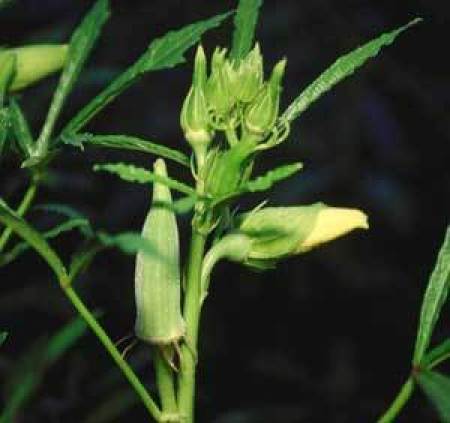
Abelmoschus esculentus
Traditionally a southern favorite, Okra is a member of the hibiscus family that produces, small, slender, edible green pods, with a mild flavor and ridged texture. When cooked, the pods release a viscous substance that is sometimes used as a thickening agent. Prefers warm climates
Start indoors three to four weeks after the last frost date or sow seeds directly outdoors when soil warms to 68ºF. Warm climates can start a second crop in early summer.
full sun
deep, fertile, well-drained soil with a pH of 6.5 to 6.8
Keep soil evenly moist (not wet) to encourage continuous production of pods. Plants are susceptible to stem rot, so avoid getting water directly on plants.
Mulch around plants to control weeds and retain soil moisture. Apply an organic fertilizer, like compost tea, every few weeks to boost production.
Pods should be harvested when they are young and tender and have reached a length of 1 to 6 inches. Harvest frequently to keep plants producing. Okra is highly perishable and should be frozen, pickled, canned or eaten within 24-48 hours of harvesting. Dry over-ripe pods for arrangements.
Common okra problems include cabbage worms and aphids. Remove worms by hand and spray aphids with an organic insecticide or spray them with a hose.

Add your voice! Click below to comment. ThriftyFun is powered by your wisdom!
Thanks for printing an article on how to grow Okra. I live in New England, and would like to try it in a few large containers next year. If I use organic soil for potting early started plants, do I need to mix anything else into the soil 1st to ensure an abundant growth when transplanting outside; ie: fertilizer or lime, or some other soil amendment so the PH will be right?
Do I use just plain seed starting soil to start them & do I need to use heating pads or lights? Hope you can answer this in a future article or as feedback on the site. I love southern foods & growing my own foods to save $, but it can get expensive when you invest time, labor & $ & nothing comes up. I'd like to get it right the 1st time. Thanks for any help.
Add your voice! Click below to comment. ThriftyFun is powered by your wisdom!